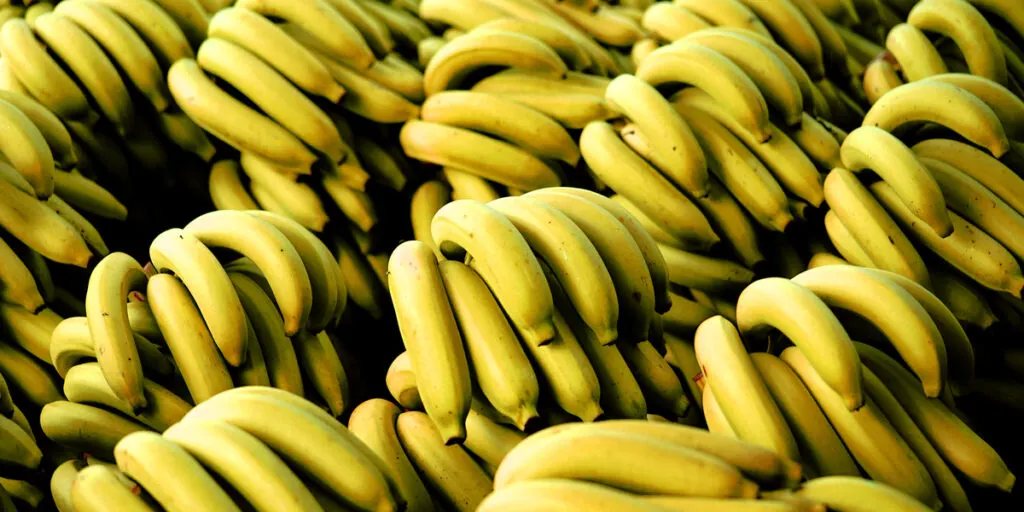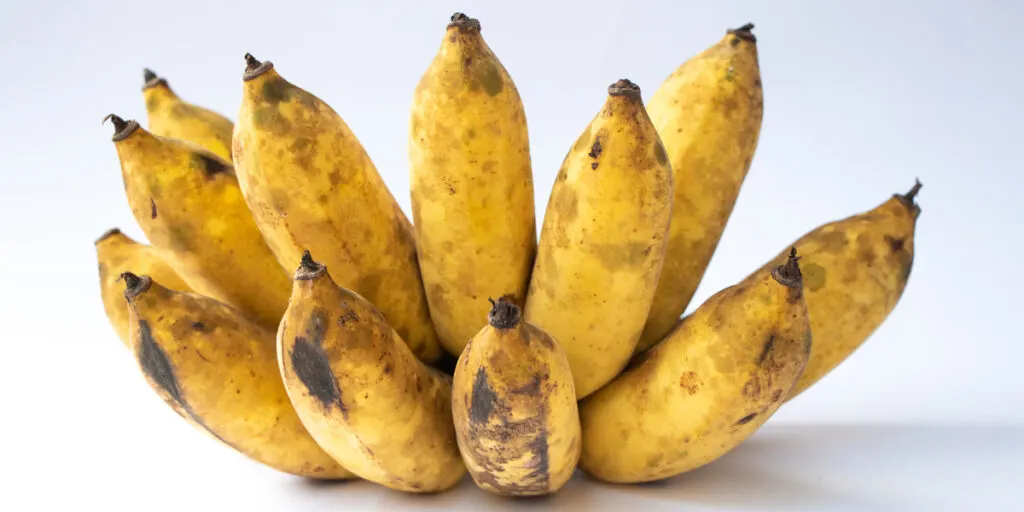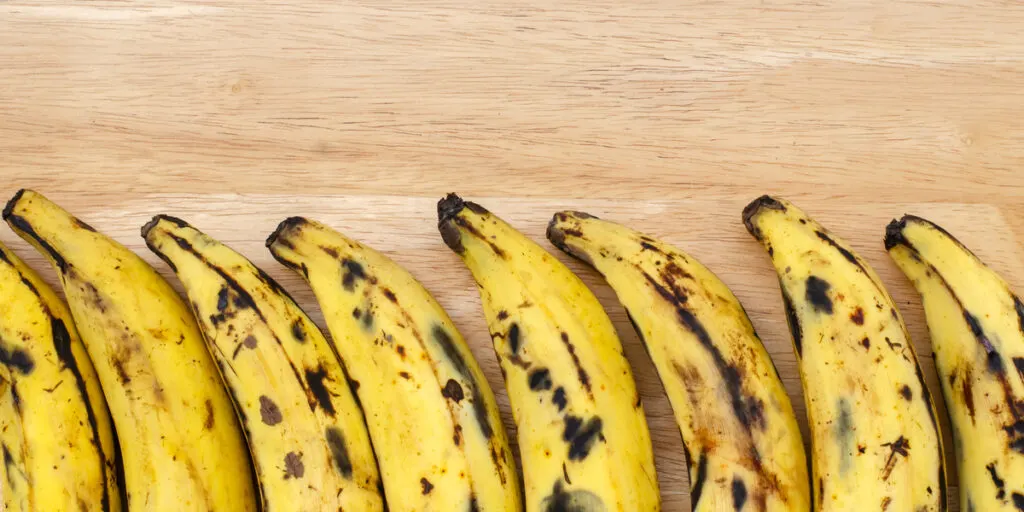Do you know bananas are classified botanically as berries? It’s true! Bananas have soft skin, they grow from a single ovary, they have small seeds, and they have a fleshy middle, so they qualify as both a fruit and a berry.
There are over 1,000 varieties of bananas grown around the world. Each variety has unique characteristics, such as taste, size, and color. Some banana plants are cultivated commercially, while others are grown in gardens or are found in the wild.
To classify a banana, you use its fruit characteristics, time of flowering, and geographic distribution.
Table of Contents
Dessert Bananas and Plantain Bananas
Dessert bananas are bananas that you can find easily in grocery stores. They are yellow with firm flesh.
Dessert bananas have a sweet flavor and creamy texture.
They do not require cooking, and you can eat them raw and use them in fruit salads or desserts. Some popular dessert banana varieties include Cavendish, Lady Finger, and California Gold.
On the other hand, plantain bananas are large, firm bananas that have a starchy texture and taste like potatoes when cooked. You can only eat plantains after cooking them. You may have eaten them fried, baked, or boiled.
It is possible to substitute plantains for potatoes because they have a similar taste and texture. The color of plantains changes as they mature. Immature plantains are green in color, but they become yellow or black as they ripen.
This transition from green to yellow to black signifies a change in texture from hard to soft, which makes it easy for you to determine whether you should cook the plantain or eat it raw.
Here are specific types of bananas found around the world.
1. Cavendish

This is the most common type of banana found in farmers’ markets or grocery stores in the United States, and it is known for its bright yellow color and easy-to-peel skin. It is long and slender and has a sweet flavor with a creamy texture.
Cavendish bananas are commonly used in desserts, such as banana bread or muffins. Or they can be used as a snack or side dish.
Cavendish bananas never go out of season. You will find them at the grocery stores, farmers’ markets, and supermarkets all year round. Some of the important Cavendish cultivars produced through selective breeding are:
- Dwarf Cavendish
- Grand Nain (Chiquita banana)
The Cavendish variety is grown across Central America and is the most internationally traded banana. Thus it’s an important plant with huge economic benefits for the regions that grow it.
2. Red Banana

As the name implies, these bananas have a reddish-purple hue on their skin with a cream-colored pulp inside. The flavor is sweet with hints of raspberry, mangoes, or strawberry when fully ripe.
Red bananas are smaller than Cavendish bananas, with a shorter length and wider diameter. The color of the peel will vary depending on the antioxidant content in the banana. The banana peel shows several brown spots as it ripens. The flesh is yellow-orange to light pink.
Red bananas are rich in vitamin C compared to other types of bananas. If you want to eat a sweeter red banana, choose one with black spots on the skin.
You can use red bananas for toppings over pancakes or incorporate them into fruit bowls or ice cream. You can also use red bananas to sweeten food dishes and to thicken and sweeten curries. Red bananas stay fresh longer than yellow bananas do.
3. Burro Banana
The burro (Bluggoe or Orinoco) banana is a cold-hardy banana cultivar that is shorter and sturdier, with a thicker peel than other varieties. It has a box-like shape with green skin that turns yellow with black spots when ripe.
An unripe burro banana has a chalky potato-like texture. When fully ripe, the flavor is mild with hints of lemon and orange.
Burro bananas are six inches long on average and are among the healthiest bananas, with many benefits.
They are low in fat, low in calories, and have lower carbs when compared to other bananas. They have been known to lower blood sugar levels and increase hemoglobin levels in the body.
The burro banana plant can grow from three to six meters (six to eighteen feet). It produces small, thick bananas that are about five centimeters (two inches) long. Burro bananas turn yellow and darken faster if you don’t harvest them when they are still green and firm.
Burro bananas contain high levels of key minerals such as magnesium and potassium. Burro bananas are also rich in:
- Fiber
- Vitamin B
- Vitamin C
- Phosphorus
- Calcium
- Copper
- Selenium
- Magnesium
- Iron
- Zinc
The burro banana is also resistant to Panama disease.
You can enjoy eating burro bananas ripe, fried, or baked.
4. Lady Finger Banana

Lady finger bananas are small, sweet bananas known for their easy-to-peel skin and deliciously creamy texture.
The Lady Finger banana has a thin skin that is much easier to peel than other varieties. This type of banana is a variety of Musa acuminata and is a popular South Pacific variety native to Australia and Southeast Asia.
Lady Finger banana plants can grow up to 25 feet tall if you fertilize them properly. You can also grow them as ornamental plants in their dwarf state.
Lady Fingers are one of the most popular banana varieties in Australia and are often used for dessert. They are also known as sugar bananas, fig bananas, and date bananas because they have a sweet flavor that is reminiscent of figs and dates.
Lady Finger bananas are very unique as they don’t turn brown when cut and are thus a favorite for fresh applications like fruit salads.
The skin of a Lady Finger banana turns from green to yellow, and you can refrigerate it for up to three months without it losing its flavor or texture. Use these bananas in baking, fruit salads, or smoothies.
5. Gros Michel

Gros Michel bananas are the variety of bananas that were most popular in the first half of the 20th century. The Gros Michel bananas, which are native to Southeast Asia, were the main export banana until the 1950s when it was almost completely wiped out by Panama disease. Since then, the Cavendish banana replaced Gros Michel to become the dominant cultivar.
The skin of a Gros Michel banana is smooth and relatively thick compared to other varieties of modern bananas. This made it easy to export as the skin formed a protective layer keeping the banana flesh intact.
The banana skin of a Gros Michel turns from green to yellow as it continues to ripen. The flesh is white and firm when unripe, turning creamier as it softens with age. When ripe, its flavor is sweeter and richer than the modern Cavendish variety.
6. Apple Bananas/Latundan Bananas
Apple bananas, also known as Latundan bananas, have several characteristics that set them apart from other varieties. These unique bananas are known for their apple-like flavor.
Apple bananas can reach a height of up to 13 feet and require partial or full sun exposure. The skin of a ripe apple banana is yellow with a few brown spots and later forms brown-black markings as it ages.
The flesh of an apple banana is cream-colored and has a very mild flavor that has been described as tasting like apples or pears. When ripe, the flesh of the banana has a soft and sweet tangy flavor. You are bound to find it in grocery stores all year round.
You can also grow this popular dessert banana as an ornamental plant.
7. Pisang Raja

Pisang Raja bananas are a seedless variety of banana that is grown in Indonesia. The bananas are small and have an elongated shape, with a thick curved tip.
Pisang Raja bananas have a strong sweet flavor and have a firm texture that doesn’t crumble when you fry them. Pisang Raja bananas have darker flesh that is almost orange, while the skin is easy to peel.
Pisang Raja bananas have a distinctive flavor that differs from other types of bananas. These sweet, creamy bananas are often used to make Indonesian banana fritters, which are called Pisang Goreng in that country.
Aside from frying them, you can enjoy ripe Pisang Raja bananas on their own or use them as an ingredient in desserts such as cake and ice cream.
8. Praying Hands Bananas
Just as the name suggests, praying hands bananas look like two hands that are fused where they meet. The “hands” contain about six to seven fruits fused to each other. Each Praying Hands banana is a small banana that is less sweet with a tinge of vanilla flavor. The skin is yellow and the texture is crisp.
Praying Hands bananas are a seasonal variety, and they are mostly available in the winter and fall months.
Praying Hands bananas are high in potassium, carbs, and fiber. They also contain:
- Vitamin A
- Vitamin C
- Magnesium
- Phosphorus
- Iron
- Zinc
- Calcium
- Copper
Praying Hands bananas are native to the Philippines and Indonesia, and you can grow them throughout the South Pacific. You can grow Praying Hands bananas, too, as an ornamental plant.
You can find Praying Hands bananas in grocery stores and farmers’ markets. You can cook these bananas, or you can eat them raw.
9. Fehi/Fe’i Bananas

Most people cultivate Fehi bananas for their fruit. They have a distinct appearance. You can easily identify Fehi bananas by their erect bunches of bananas, their red or brilliant orange color, and their orange flesh.
You will find them in abundance in French Polynesia, and their origin is said to be New Guinea.
The introduction of other types of bananas has caused this type to be rare. Fehi has been a staple food in Indonesia and Tahiti but is not eaten raw. Fehi contains a high amount of beta carotene, which converts to vitamin A in the body.
Unfortunately, Fehi is susceptible to pests and diseases, produces fewer suckers, and takes a long time to produce a bunch of bananas.
10. Blue Java Bananas
Blue Java bananas are a variety of bananas that originated in Southeast Asia. The fruit is known for its sweet flavor, creamy texture, and unique blue peel.
The Blue Java banana is also known as ice cream banana, Hawaiian banana, and Krieger banana. It has a very strong branch structure and can grow to a height of about 15 to 20 feet.
Blue Java bananas are quite different from other varieties of bananas due to their unique flavor. Their taste is often compared to vanilla ice cream, which is the reason why they are called ice cream bananas or Hawaiian bananas.
Blue Java bananas are also popular because of their attractive appearance. The blue peel has a tinge of green when unripe and is pale yellow when ripe. You can enjoy this banana raw, or you can cook it first to enjoy its delicious, unique taste.
11. Macho Plantain Bananas

The Macho plantain is a large, starchy banana that looks similar to a squashy cucumber. It is usually eaten cooked and has a distinctive flavor. Plantains (cooking bananas) are starchy, like potatoes, and have thick skins.
Plantains are usually harvested unripe when they’re green and starchy and need cooking. When they ripen and turn yellow, you can eat them raw like a normal banana, but the flavor is slightly different.
Plantain bananas are used in savory dishes like curries and are often fried in slices. They’re also eaten boiled, mashed, in stews, in soups, grilled, baked, or as a side dish.
The plantains are classified into two groups: macho and cuadrado. The macho group has a larger fruit size and is resistant to diseases.
Conclusion
There are over 1,000 banana types in the world. Some of which you may have seen and eaten, while some may be new to you. Some are wild bananas, some are grown for their ornamental value, and some are grown for food in home gardens and on commercial farms.
Each banana type has characteristics that make it special. The information we provided should give you a good idea of the different varieties of bananas and what they taste like.
Resources
- https://www.healthline.com/nutrition/bananas-berries-or-fruits#bottom-line
- https://www.sciencedirect.com/topics/agricultural-and-biological-sciences/bananas
- https://en.wikipedia.org/wiki/Cavendish_banana
- https://alkalineveganlounge.com/what-are-burro-bananas-101-facts-you-need-to-know/
- https://en.wikipedia.org/wiki/Lady_Finger_banana
- https://homeguides.sfgate.com/lady-finger-banana-trees-44621.html
- https://en.wikipedia.org/wiki/Latundan_banana
- https://dbpedia.org/page/Fe’i_banana
